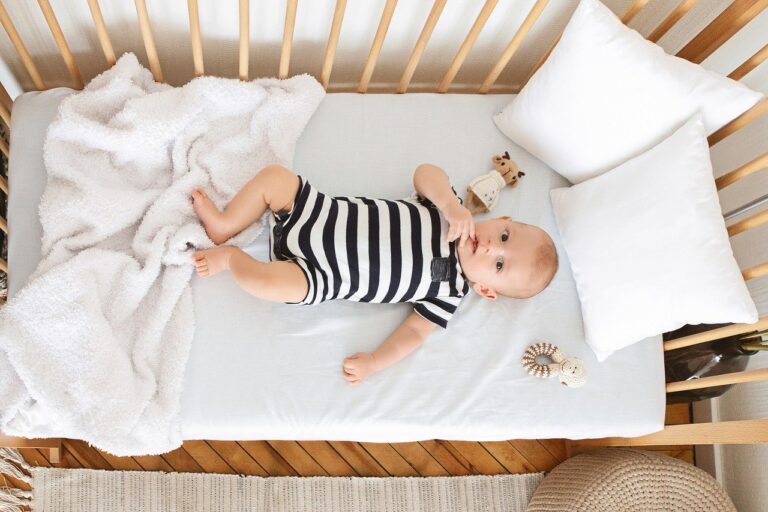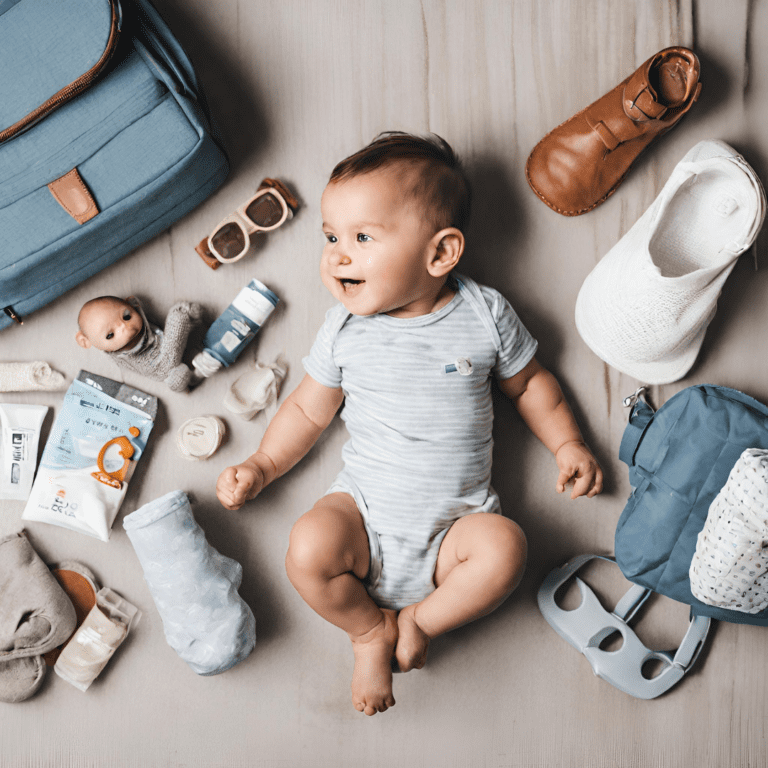Complete Baby Proofing Checklist: Essential Tips And Tricks To Baby Proof A House

Baby-proofing a house has always been necessary for every parent to ensure child safety. There are so many things we place in the house that might be casual or safe for us as adults, but at the same time, they can be harmful to the little ones in our homes. Moreover, these elements can cause serious injuries to babies who are in the phase of dealing with their first move.
“National Safety Council organization” (nsc.org) also claimed that major accidents with toddlers happening in the house are life-threatening in many cases. According to ncs.org household accidents can be prevented by applying some baby-proofing solutions in the house.
If you are a parent looking forward to getting some real guidance to make your house safer for your child, then you are at the right place. In this article, we will explain the complete baby-proofing concept along with the baby-proofing checklist. We will also discuss how you can childproof your house independently if you don’t want to involve any childproofing consultants. So, let’s get started with understanding what exactly babyproofing is.
What is Baby Proofing?
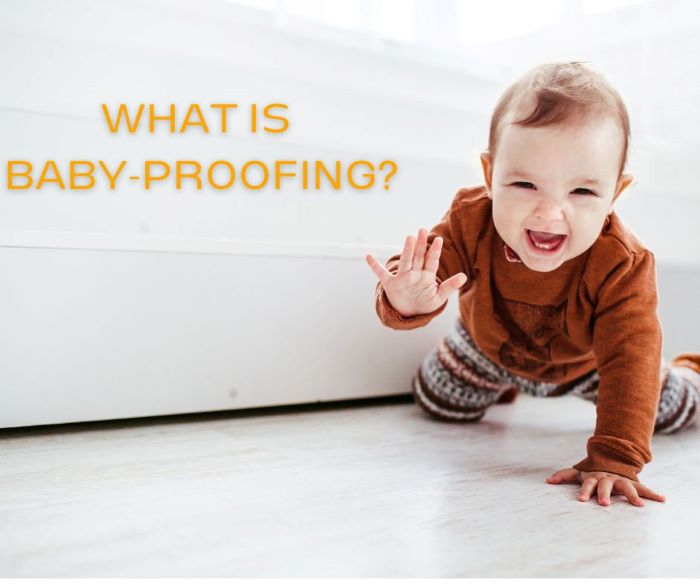
Babyproofing or childproofing is a solution to make the house safer for babies and toddlers to roam around without fearing household accidents. In this child-proofing activity, major areas, accessories, or essentials of the house are covered to prevent child access.
Furniture anchors for wobbly pieces of furniture, door or cabinet locks to restrict child’s unsafe access, tower bolts for doors, top and bottom stair gates installation, plug covers to cover exposed power plugs, covering sharp edges of furniture with corner guards, etc. are some of the activities of house baby proofing.
Why Is a Baby-Proofing House Necessary?
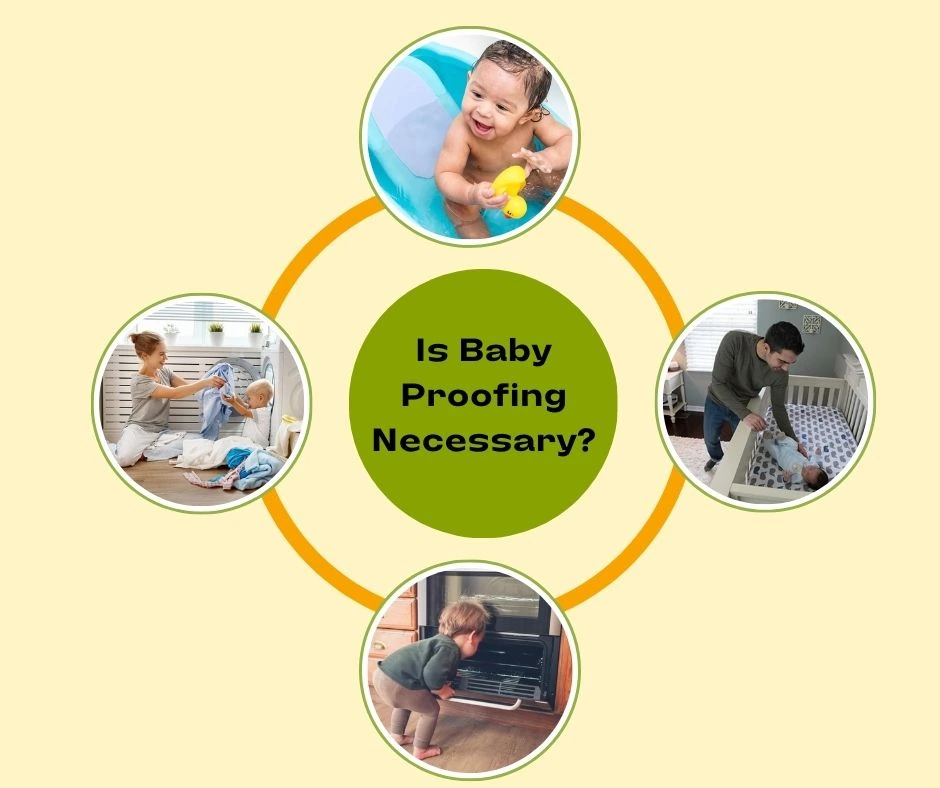
Every area of the house has a minimum or maximum risk for blooming babies. These risks can be anything from stairway falls to injuries from sharp-edged furniture or accessories of the house, curious access to the power supply and water supply outlets, contact with chemicals, paints, or cleaning supplies, and many others.
Childproofing consultants and many child safety organizations claim that proper house childproofing assistance can prevent these unfortunate accidents and injuries. In addition to this, babies can safely explore and enjoy their tiny activities without adult intervention.
Another least important aspect of baby proofing is to avoid damage to valuable accessories or pieces of the house from the baby’s unconscious and curious handling.
What Are the Basics Of Baby Proofing House?

Childproofing experts say this activity can be performed after a house evaluation. The following pointers will guide you to a certain level of understanding of the basic stages of house child-proofing.
1. Proper House Evaluation
If you are looking for professional assistance in house baby proofing, this will be the first step to proceed with the activity.
Here, a child-proofing consultant will visit your house and inspect the areas where actual risks are involved with the baby. After the house inspection, they will suggest a solution for the products and installation.
If you are not interested in professional assistance, evaluate your house thoroughly, keeping the smallest elements in mind.
2. Eliminate Harmful Elements
During house evaluation, you will notice the smaller elements like loose cords at the bottom of the wall, loosely fitted door stoppers, sharp objects, wobbly furniture and decor pieces, floor lamps, etc. All these things can be harmful to babies if not noticed and kept as they are.
So be aware of those dangerous spots and eliminate or relocate the elements from the baby’s reach.
3. Listing Down The Necessary Child Proofing Products
After a thorough house inspection, you will know the required products. Create a baby-proofing checklist where you can mention the list of products needed to child-proof a house.
Different parts of the house will need additional child safety product installation in most cases, i.e., the kitchen, hallways, common area, balcony, stairs, cabinets, etc., need to be secure with certain products.
4. A list of some primary child-proofing products
baby gates

Non-toxic Playmats

cabinet Locks

Cabinet Safety Locks

Furniture Safety Guard
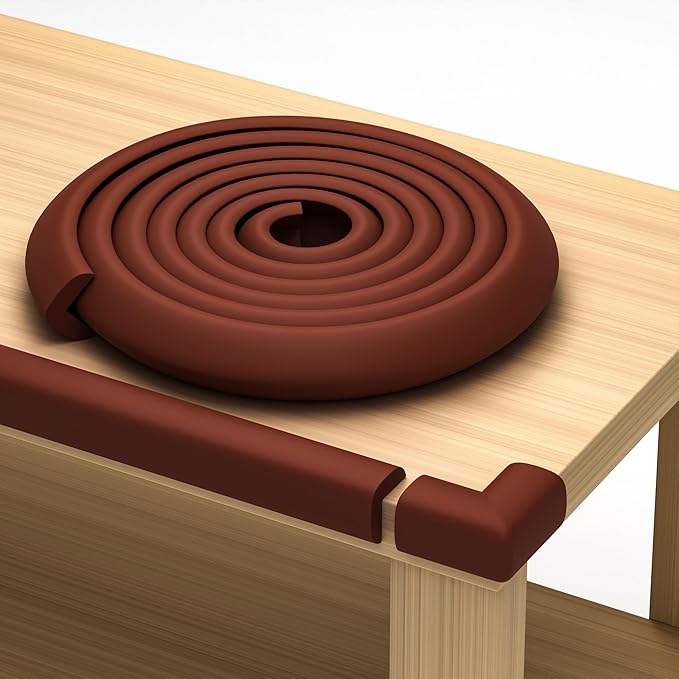
Heat-resistant Resistant Door locks
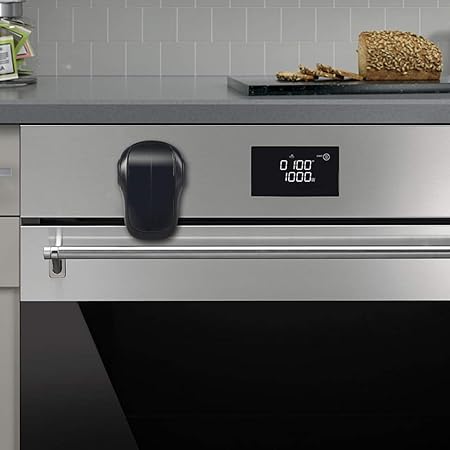
Furniture Anchors
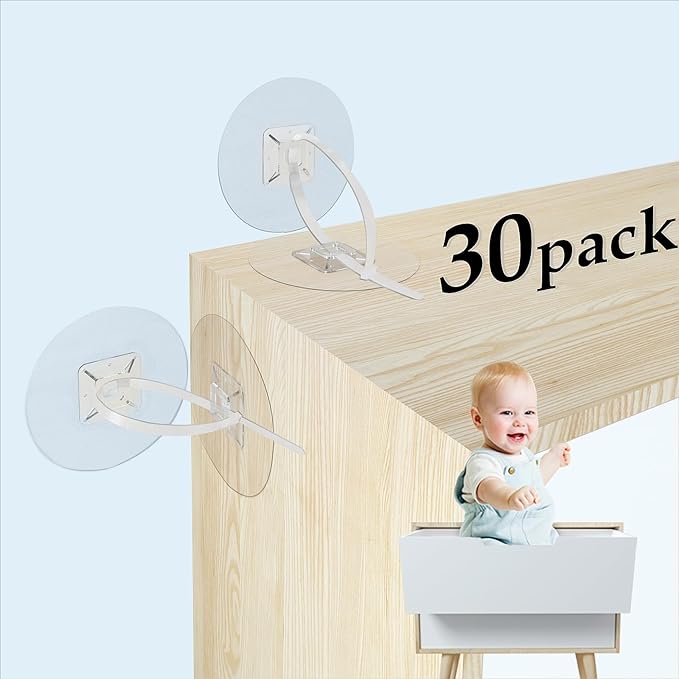
Toilet Seat Lock
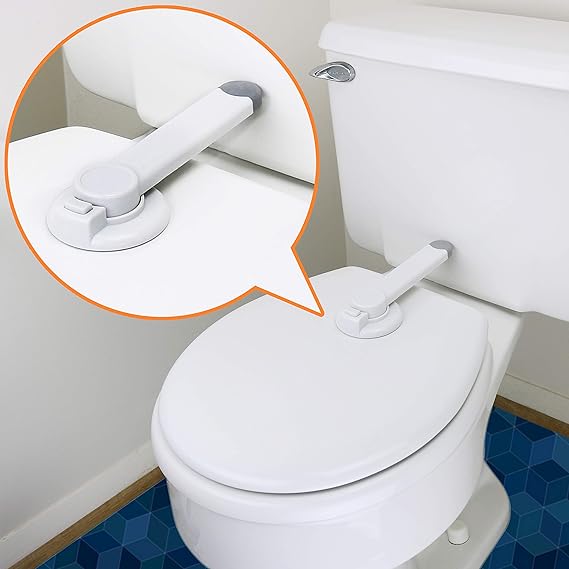
Cable Organizer
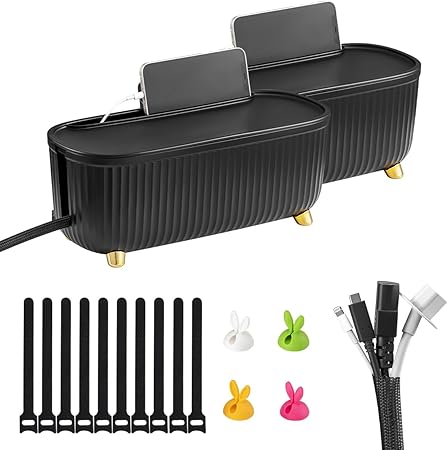
5. Installation Of Baby Safety Products
Proper installation of baby safety products is essential for a baby-proofing house. Taking professional help in the installation will be the best decision for child-proofing to ensure the safety of babies. A professional child proofing expert knows the loopholes of this activity with a huge amount of experience in baby proofing they have gained through various types of houses.
On the other hand, if you are installing the products yourself, check the certification before buying them. Always choose “JPMA Certified” products for child safety, as they are approved after different stages of quality checks. Properly check the user manual or guide before installing the products. Check out the product installation videos on the internet. After understanding the process, start the installation.
6. Keep checking on the Installed Baby Safety products
Most of the time, when you complete the baby-proofing house activity, you think it is safe for the baby. However, it is not completely safe if you are not monitoring them for longer. Unfastening, damage, or wear and tear on the products can put your child in a dangerous situation.
So keep checking the overall baby-proofed areas to see if they work fine and are safe for babies.
How You Can Baby Proof Your House Independently?
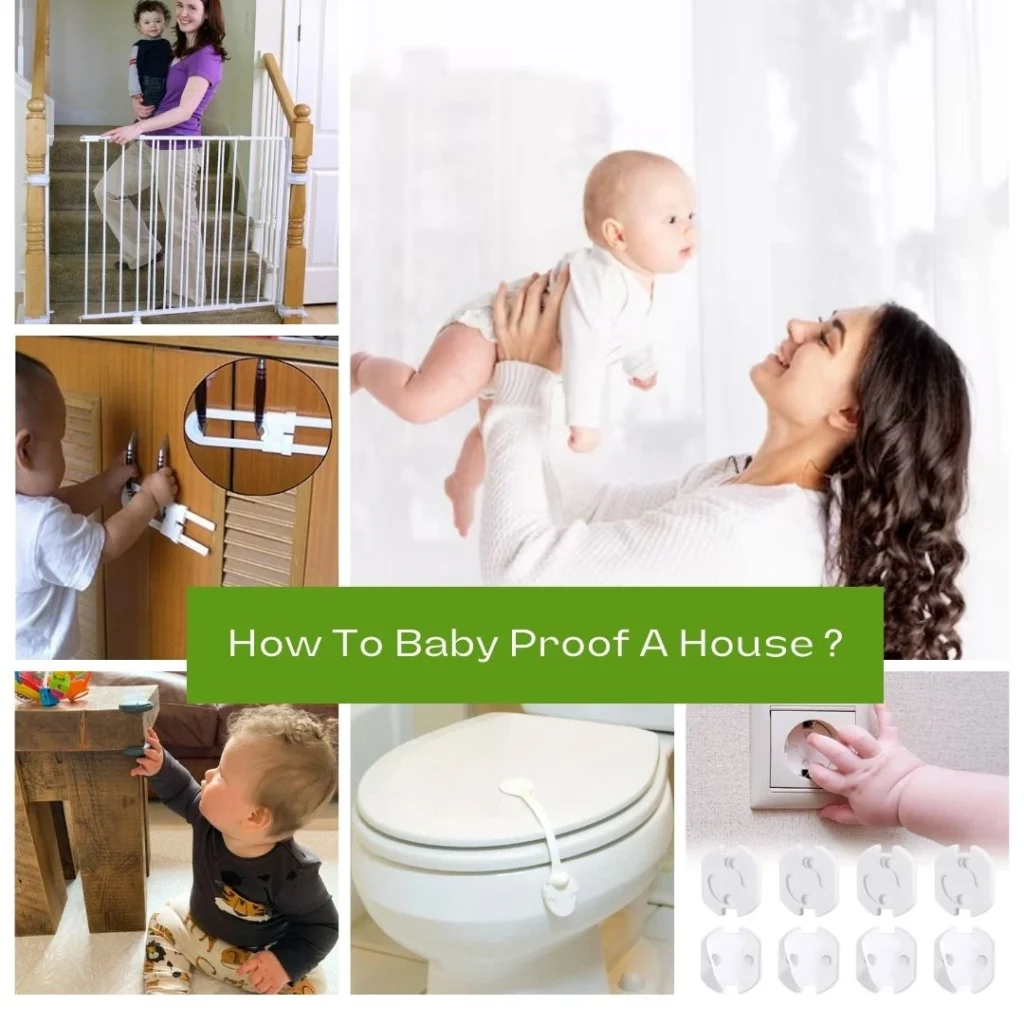
Baby-proofing a house is an activity you can do better with professional assistance. However, if you are unsure about complete assistance, you can implement this activity independently with partial professional assistance.
We have already discussed the basics of babyproofing in an earlier part of the article. Those pointers will guide you in your independent childproofing activity. You can also start the baby-proofing house with different sections of your house. Following are area-wise baby-proofing products and instructions that will make your baby-proofing activity easier.
1. Area Wise Baby Proofing Checklist
Drawing Room or Living Room
Generally, common spaces of a house, like drawing rooms or living rooms, consist of particular elements such as TV, furniture, showpieces, carpets, fireplaces, bookshelves, etc. Hence, one should deeply analyze things to make a better and safer place for the baby.
Baby proofing tips to apply in your living room
- Use soft corner guards to cover the sharp edges of furniture.
- Install long baby safety gates if the living area is huge.
- Childproof all the power outlets with outlet protectors.
- Use non-toxic and anti-skid play mats in the living area.
- Prevent baby’s cabinet access with cabinet locks.
- Try to mount a TV on the wall or anchor it using safety straps.
- Loose furniture, like bookshelves, tables, etc., lands them using furniture anchors.
- Add screens to fireplaces.
Bedroom
At some point in time, the baby will start exploring the house. Babies are curious about everything and places, and the bedroom is one of them. Usually, bedrooms are accessorized with elements such as beds, study tables, wardrobes, cabinets, etc. Baby-proofing cabinets, wardrobes, tables, and other risk-increasing things are a must-apply process, especially for bedrooms.
Baby proofing tips to apply in your Bedrooms
- Fully cover all low-profile and sharp-edged furniture pieces like beds, tables, and ottomans with furniture safety guards.
- Install child safety door locks for bedrooms and attached bathrooms.
- Place strap locks on wardrobes and cabinets.
- Anchor wobbly furniture items using furniture anchors.
- Medicines, accessories (jewellery, perfume, personal care products), batteries, etc., should be kept out of reach of babies.
- Place electric outlet covers on power plugs and use cable organizers to hide loose wires.
- Install baby gates for stairs if a bedroom is located upstairs.
Kitchen
The kitchen is the most unsafe part of the house for your little explorers, as it is loaded with electronic appliances, kitchen accessories, cleaning supplies, and other elements that can harm babies. It is claimed that this area can cause serious choking hazards, burns, cuts, and shocks to a baby.
Baby proofing tips to apply in your Kitchen
- Attach child safety locks on all electronic appliance doors (refrigerator, oven, dishwasher), kitchen cabinets, and drawers.
- Relocate all the cleaning supplies and chemicals from the lower cabinets and place them in more safe areas.
- Cover the stove knob covers after finishing the stove area usage.
- Avoid front-burner usage and try to use back-side burners.
- While cooking, put utensil handles on the side to avoid accidental handling and injuries.
- Always use a high chair for the baby with safety belts.
- All sharp elements- forks, knives, scissors, and other chopping, cutting, and eating elements must be out of reach of your little ones.
Nursery
An important and primary area for babies is the nursery room. Baby proofing of a nursery is an essential task to follow. However, it will look easy to do the childproofing activity since it includes minimum items, i.e., nursing table, crib, monitoring device, mini wardrobe, toys, etc. However, the nursing area of the house needs special attention in baby-proofing.
Baby proofing tips to apply in your Nursery
- Anchor all the furniture items, like the nursery’s nursing table, shelves, standalone wardrobes, etc., using furniture anchors.
- Put screen or window guards on the nursery windows.
- Don’t put any cords or strings around the baby’s reach, as it can cause strangulation.
- Avoid placing pillows, blankets, soft toys, etc, in the crib. Just put a crib sheet.
- Place the monitoring device high on the wall.
- Put baby essential products out of the baby’s reach.
Laundry Room
This area of the house is also considered dangerous for kids. It consists of equipment like a washing machine, cloth dryer stands, water outlets, etc., so most childproofing experts advise installing baby gates for laundry rooms to restrict child access. If installing a gate is impossible, then a few precautions are necessary.
Baby proofing tips to apply in your Laundry Room
- Keep all the laundry essentials out of reach of the child.
- Secure water outlets and make sure they are not easily accessible for kids.
- Use furniture anchors or straps to anchor furniture firmly.
- Add safety locks on the cabinets and washing equipment.
Download Our Complete Baby Proofing Checklist
Take a look and download our summarized Baby Proofing Checklist to enhance your house’s babyproofing journey. Click below to get the PDF checklist and Excel sheet now!
General Tips
- Make a proper baby-proofing checklist after completing the house inspection.
- Start a baby-proofing house before the baby turns 3 months, as childproofing consultants claim that the rolling activity of a baby also demands certain types of safety for the baby.
- Try to take advice from baby-proofing consultants.
- Use the best baby-proofing products and check on the installed baby-proofing products regularly.
- Avoid installing used baby-proofing pieces as it has wear and tear damage possibilities.
- Maintain a clean and healthy environment in the house.
- Don’t keep a baby unattended at any time or in any situation.
Conclusion
First and foremost, babyproofing or childproofing should not be implemented as if it would be a cage for babies and inaccessible for adults in the house. Child safety is an important and primary reason for baby-proofing houses. Hence, this activity should be done with proper professional guidance.
In some cases, parents choose to do this childproofing activity independently. Though it is fine to go with, some precautions are necessary to take care of.
We have provided some important aspects of the baby-proofing house for those parents who want to know about the baby-proofing concept and are eager to implement it independently in this article. Here you will better understand the whole child-proofing concept, its application in the house, and the list of primary products to start your independent house baby-proofing journey.
FAQ
What does baby-proofing mean?
To explain baby proofing in simple terms, baby proofing is a wiser solution to keep infants away from household accidents and injuries.
To baby-proof a house, you need to make some changes. For instance, installing particular products like cabinet locks, door safety locks, furniture safety guards, baby gates, etc., and making some basic changes like keeping harmful supplies, utensils, accessories, etc., out of reach from the baby.
What are the benefits of baby proofing?
The prime benefit of baby-proofing is your baby’s utmost safety from accidental household injuries. Apart from this, the baby can explore every corner of the house freely without making you worry about injury.
It might be the least important benefit of baby proofing where you can secure overly expensive house elements from a child’s unintentional handling.


